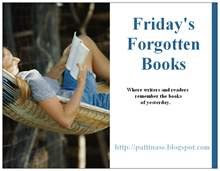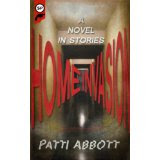
Happy Birthday, Josh. You are the greatest!

Hannah Stoneham is a book worm, aspirational writer and occassional cook. She lives in France and keeps a record of her reading at www.hannahstoneham.blogspot.com.
Forgotten Book Friday:
WHO WAS CHANGED AND WHO WAS DEAD, Barbara Comyns
Who Was Changed and Who Was Dead is the story of a family, a household and a village in a time of flood, plague and savagery. The year is 1914 and the family is that of widower Ebin Willoweed. Ebin is the lethargic home tutor to his three motherless children – Emma, Dennis and Hattie. He is also the dependent and resentful son of the rich forbidding matriarch – Grandmother Willoweed. Grandmother Willoweed is an old tyrant with a forked tongue who refuses to step upon land that she does not own. The wider household includes their tender maids – the sisters Norah and Eunice – and their gardener – the frank speaking, keeper of traditions – Old Ives. Beyond the gates of their manorial home sits a community wider still; the doctor, the baker, the farmer, the miller, the rector, the idiot; their wives, their lovers, their children. As the novel opens the river has burst its banks and flooded the house and the village. Ducks swim through windows and Ebin rows his daughters around the garden in a small boat. Everything is displaced. But soon it will be worse – for plague follows flood and madness follows hard behind. Who will be changed by it, and who will be dead?
The tone of this tale is surreal and slightly magical – but it is not meaninglessly strange. Rather – bizarre happenings and peculiar interludes are used to illustrate themes that are close to us all. Barbara Comyns explores snobbery and insecurity alongside kindness and understanding. She explores the casual cruelties of family life, the odd traps of domesticity, the secrets and lies that lurk in every household. She shows how people can become displaced – by their own attitudes and the mentalities of others. The characters that she creates are powerful because they are candid. Although the moral compass is stronger in some than it is in others, everyone in this stricken village has more than one side – there are no pantomime villains or heroes beyond reproach. Barbara Comyns builds a topsy-turvy world and uses it to illustrate a landscape of great familiarity.
This is not a story without horror. Indeed, the grotesque descriptions of the damage caused by the flood led to the book being banned in Ireland when it was published in 1954. Barbara Comyns was not a user of the euphemism. She wrote frankly and unapologetically. But if a history of censorship suggests to you that this book might be gratuitously unpleasant – then her history of censorship has done Barbara Comyns wrong. In Who Was Changed and Who Was Dead there is an overwhelming feeling for the profound and confusing oddness of everyday life. The true horrors of the novel are the ease with which people will turn to violence – the speed with which they will lose compassion – the comfort which they will take from prejudice. Alongside this disturbing narrative – there are also the unexpected new beginnings that emerge from chaos – the happier, surer future beyond the disaster. This is a lyrical and humane book which ought not to be forgotten.
Simon at Stuck-in-a-book and Verity at Verity’s Virago Venture have also enjoyed Who Was Changed and Who Was Dead. The book is available quite cheaply on Amazon.
Ed Gorman is the author of TICKET TO RIDE, THE MIDNIGHT ROOM and many other f ine books. You can find him here
ine books. You can find him here
The Fog, James Herbert
My favorite Herbert is titled The Fog and it continues the long and heralded tradition of the British disaster novel. Sometimes the disaster is an alien invasion as with H.G. Wells and sometimes the disaster is unworldly seeming yet of our world as with the great John Wyndham.
In Herbert's novel a yellow fog begins moving across England causing much of the population to go insane and begin committing atrocities on family, friends and anyone else they can get their hands on. Even animals go insane; pets become killers. A group of scientists in a bunker race to learn why one of them is immune to the effects fog.
What raises this story to the level of a classic is not just the shock effects--Herbert can jolt the most jaded of readers--but the portraits he draws of his people. He cuts across all ages and all classes. Unlike most Big Bestsellers he makes us care about them and in so doing he gives the reader the race-against-the-clock story with the scientists and the anxiety of seeing real people face their fates.
Centipede Press has just issued a collector's edition of the novel complete with a beautiful cover homage to the U.S. paperback edition and a long, fine introduction by horror legend Ramsey Campbell.
Thought it's a lengthy novel, I read this new edition in two sittings. It's a thriller that truly belongs on the same shelf as H.G. Wells, the early catastrophe novels of J.G. Ballard and the classic work of the late John Wyndham.
Paul Bishop
Bill Crider
Mike Dennis
Martin Edwards
Randy Johnson
George Kelley
Rob Kitchin
Evan Lewis
Steve Lewis/William F. Deeck
Todd Mason
Eric Peterson
James Reasoner
Rick Robinson
Kerrie Smith
Kevin Tipple















5 comments:
Let me second Ed's recommendation for Herbert's THE FOG. I read a lot of his books and this is probably the most powerful and fastest moving. And it has nothing to do with either movie version, being far superior to both.
THE RATS trilogy is also good, if you can stand the thought of mutant giant killer rats. The Canadian-made movie version used French poodles as stand-ins for the rats! ISIANMTU)
Herbert also wrote an alternative history novel set in post-WWII London called '48.
Jeff M.
Nice to see James Herbert getting a hat tip. I like pretty much everything I've read by him.
I liked that James Herbert book a lot.
And, as I noted on Ed's blog, Herbert's THE FOG shouldn't be confused with the movie about the vengeful ghosts of pirates, which was novelized pseudonymously by Dennis Etchison, no less (one of the great horror/suspense writers of our time).
As I didn't write on Ed's blog, Stephen King caught the wave of the horror industrial complex that had been established by Ira Levin (and to some extent Shirley Jackson and David Ely and Robert Bloch) in the mid '60s and amplified by William Blatty's great success (and to some extent that of Fred Mustard Stewart and Thomas Tryon) and King became the It Man of Horror (though still rivalled by the likes of Anne Rice and VC Andrews in the latter '70s--there are many that Kind is not more talented than, but he is more talented than Andrews or Rice).
And mine, lubricated by sleeping in and a DayQuil knockoff, ah the dissolute life of the publishing drone, is finally up.
Post a Comment